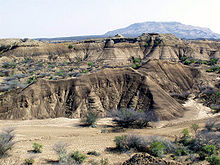- Omo Kibish Formation
-
The Omo Kibish formation is one of several sites within an ancient rocky formation called Kibish. The Kibish outcrop is where excavations by Richard Leakey and others recovered Homo sapiens remains as old as 125,000 years BCE. Omo Kibish-1, also known as Kamoya's Hominid Site (KHS), contained a nearly complete skeleton of an adult male Homo sapiens.
The Kibish outcrop is named after the nearby village of Kibish, one of the villages of the Nyangatom people. The village lies close to the east bank of the Omo River at the base of the Nkalabong Range in Ethiopia. The Omo Valley is extremely rich in significant palaeo-anthropological remains. According to scientific research (done in 1982 by the University of California at Berkeley), hominid remains from the Omo Valley date back more than four million years.
However, more recent potassium-argon dating of the volcanic tuffs at Omo Kibish-1 suggests that they date between 104,000 and 196,000 years ago, and that the likeliest date is closer to 195,000. If this date is correct, it makes Omo Kibish the earliest known Homo sapiens site on the planet.
When the bones of two early humans were found in 1967 near Kibish, Ethiopia, they were thought to be 130,000 years old. Some years later, researchers found human bones at Herto, in Ethiopia. They were dated using more modern techniques and found to be 154kya to 160kya. This initiated a new study of the 1967 fossil site, using modern dating techniques. The results at Omo Kibish-1 indicate that the earliest known members of our species, Homo sapiens, roamed Africa about 195,000 years ago.
“It pushes back the beginning of anatomically modern humans", says geologist Frank Brown, a co-author of the study and dean of the University of Utah's College of Mines and Earth Sciences. The journal Nature has published the study in its February 17, 2005, issue. Brown conducted the research with geologist and geochronologist Ian McDougall of Australian National University in Canberra, and anthropologist John Fleagle of New York state's Stony Brook University.
The researchers dated mineral crystals in volcanic ash layers above and below layers of river sediments that contain the early human bones. "They conclude the fossils are much older than a 104,000-year-old volcanic layer and very close in age to a 196,000-year-old layer", says Brown.
Sources
Source: http://www.sciencemag.org The Emergence of Homo sapiens: The Origins of Modern Humans. TUTTLE Science 17 May 1985: 868-869 DOI: 10.1126/science.228.4701.868
Categories:- African archaeology
- Archaeological sites in Ethiopia
- Pleistocene paleontological sites of Africa
- Paleoanthropological sites
Wikimedia Foundation. 2010.

